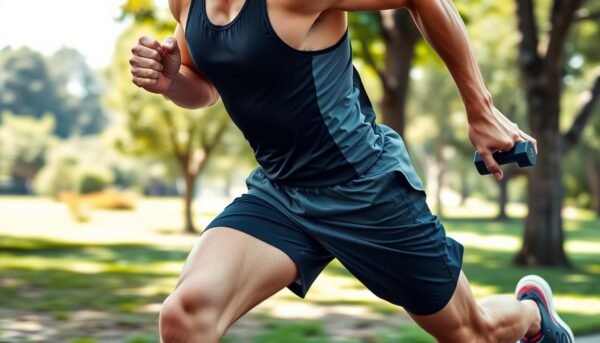As I put on my running shoes and went outside, I thought about my weight loss journey. It wasn’t easy, but I was set on making running a big part of my fitness routine. Studies say running is a top way to burn calories, which is key for losing fat.
If you want to lose 50 pounds or just get healthier, the right running plan can help a lot. We’ll look at how running boosts your metabolism and find the best running plans for weight loss. Plus, we’ll share tips to reach your fitness goals.
Understanding the Science Behind Running and Weight Loss

To reach your weight loss goals, knowing how running affects your metabolism is key. Running boosts your metabolic rate. This is crucial for losing weight and keeping it off.
How Running Affects Your Metabolism
Running is a high-intensity exercise that raises your metabolic rate. This effect lasts even after you stop running. When you run, your body uses carbs stored in muscles for energy.
But as you keep running, your body starts burning fat. This is called the “fat-burning zone.”
Calorie Burning Basics
The calories you burn while running depend on your weight, pace, and terrain. Running can burn up to 671 calories in 30 minutes under the best conditions. This is why running is great for losing weight.
The Fat-Burning Zone Explained
The fat-burning zone is when your body uses fat for energy instead of carbs. This happens after about an hour of running. It’s when your body is most efficient at burning fat.
Staying in the fat-burning zone helps you lose more fat. It supports your weight loss journey.
Knowing how running affects your metabolism and calorie burning is important. It helps you get the most out of your runs for weight loss. Using this knowledge in your training can help you transform your body.
Getting Started: Essential Running Equipment for Weight Loss Success

Starting your fitness journey? The right running gear is key. It helps you stay healthy and motivated to lose weight. From shoes to hydration tools, the right stuff makes a big difference.
First, get a good pair of running shoes. They should support your feet, be comfy, and stable. This prevents injuries and makes running better. Also, wear clothes that wick away sweat. This keeps you cool and dry while running.
- Supportive running shoes
- Moisture-wicking workout clothes
- A supportive sports bra (for women)
A GPS watch or a running app is great for tracking your progress. They show your pace, distance, and heart rate. This helps you stay focused on your fitness goals.
It’s important to stay hydrated, especially on long runs. Get a water bottle or a hydration belt. This way, you always have water when you need it.
| Accessory | Benefit |
|---|---|
| GPS watch | Tracks progress and maintains motivation |
| Hydration gear | Ensures proper hydration during longer runs |
| Reflective gear | Enhances visibility for early morning or evening runs |
Lastly, think about safety. Wear reflective gear like vests or armbands. This makes you more visible during early or late runs. It keeps you safe on the roads.
With the right gear, you’re ready to reach your fitness goals, live a healthy lifestyle, and lose weight. You’ll be motivated to succeed.
Tabata Running: The Ultimate Fat-Burning Protocol

If you want to boost your running workouts, Tabata training is the way to go. It’s a high-intensity interval training (HIIT) that burns a lot of calories. It’s great for getting rid of extra fat.
Proper Tabata Timing and Intervals
The Tabata protocol is simple. It’s 20 seconds of hard effort followed by 10 seconds of rest. This pattern is repeated for 4 minutes. It’s very effective for improving your fitness and burning calories.
Studies show Tabata can make cyclists 28% better at short, intense efforts. This is compared to regular aerobic training.
Sample Tabata Running Workout Plan
- 5-minute warm-up
- 8 rounds of 20-second sprints, followed by 10 seconds of active recovery
- 5-minute cooldown
During the 20-second sprints, try to go as hard as you can. Aim for 170% of your best effort. Even if you can’t do all 8 rounds, Tabata still works well in just 4 to 8 minutes.
Recovery Techniques for Tabata Training
Recovery is key after Tabata training. Make sure to rest well between sessions. The workout is very tough on your body.
Do gentle activities like walking or light cycling to help your body recover. This gets you ready for your next Tabata session.
Learning Tabata and adding it to your routine will help you reach your running goals. You’ll burn fat and get in shape.
How to lose 50 pounds Through Strategic Running Plans

Losing 50 pounds is a big goal, but it’s doable with the right plan. Running is key because it burns calories and boosts your metabolism. By understanding how running helps with weight loss, you can make a plan that works for you.
Research shows that structured plans help people lose weight. It takes 6 to 12 months to lose 50 pounds, depending on your start weight and how hard you try. Running more often and doing interval training can help you lose weight faster.
A study showed that running 5k a week can lead to losing over 12 pounds in a year with better eating. Runners who burned 500 calories per run, five days a week, lost over seven pounds in ten months. It’s best to run three to four times a week for 30 minutes to an hour.
Being consistent is crucial for your weight loss journey and fitness goals. Start with a plan that slowly increases your running. Use High-Intensity Interval Training (HIIT) to burn more calories and target fat. Also, eat well, drink plenty of water, and rest enough to help you lose 50 pounds.
By sticking to a good running plan and making lasting lifestyle changes, you can lose 50 pounds and start a new weight loss journey. Stay motivated, track your progress, and celebrate your wins. With hard work and the right plan, you can reach your fitness goals and become a healthier, more confident person.
High-Intensity Interval Training (HIIT) Running Workouts

Looking to burn calories and boost your metabolism? Try high-intensity interval training (HIIT) running workouts. They are great for your heart health, blood flow, and insulin sensitivity. They also help control blood sugar, reduce diabetes risk, and release happy hormones.
HIIT running is quick and fits into a busy schedule. It’s good for everyone, from beginners to advanced runners. Let’s explore some HIIT running routines for fat burning, calorie deficit, and body transformation.
Sprint Interval Training
Sprint interval training is all about short, hard efforts followed by rest. You can do it on a treadmill or outside. It’s perfect for boosting your heart health and speed. Try a 20-minute workout with 30-second sprints and 90 seconds of rest.
Hill Running Programs
Hill running adds strength and burns more calories to your HIIT routine. Try a 15-minute hill workout. Alternate between 1-minute hard climbs and 1-minute easy walks.
Recovery Between HIIT Sessions
Rest is key after HIIT, needing 24-48 hours. It lets your body recover and repair. Listen to your body and adjust rest times to avoid injury.
HIIT running is a powerful way to burn calories and transform your body. Add these interval workouts to your routine and watch your results soar!
Building Endurance: Long-Distance Running for Weight Loss

Starting my weight loss journey, I found long-distance running very helpful. It helps me build endurance and burn calories. This leads to fat loss too.
Long-distance running burns a lot of calories. A 3-mile run can burn 200 to 300 calories. This helps me reach my fitness goals faster.
To get the most from running, I do one long run a week. I increase the run’s length as I get better. For runs over 70 minutes, I eat during the run to keep my energy up.
Running long distances at a pace where I can talk is key. It helps me burn fat and build endurance without getting hurt. This way, I’m on the right path for long-term weight loss.
I also do strength training to support my running. It makes me run better and reduces injury risk. This balanced approach helps me stay in a calorie deficit and see better results.
Running long distances and doing strength training are changing my life. I’m getting closer to my weight loss and fitness goals. I’m excited to see how far I can go.
Combining Strength Training with Running Workouts

Are you working on body transformation, fitness goals, and a healthy lifestyle? Good news! Mixing strength training with running can change the game. It builds lean muscle, boosts running efficiency, and cuts injury risk.
Essential Exercises for Runners
Runners should add certain exercises to their strength training. Squats, lunges, deadlifts, and core exercises are key. They target major muscles used in running, enhancing strength and performance.
Weekly Strength Training Schedule
- Do 2-3 strength training sessions weekly for enough rest and recovery.
- Choose compound exercises that work many muscles at once.
- Slowly increase the weight and intensity to keep challenging yourself and seeing results.
Preventing Running Injuries
Strength training can also prevent running injuries. A study showed it cuts sports injuries by over two-thirds and halves overuse injuries. It strengthens muscles and improves running form, reducing risks of Achilles tendonitis, plantar fasciitis, IT band syndrome, and runner’s knee.
Consistency is crucial in running and strength training. Build healthy habits and gradually increase workout intensity and duration. This combo can unlock your body transformation, fitness goals, and a healthy lifestyle.
| Exercise | Benefits for Runners | Recommended Frequency |
|---|---|---|
| Squats | Improves leg strength and power | 2-3 times per week |
| Lunges | Targets leg muscles and improves balance | 2-3 times per week |
| Deadlifts | Strengthens the posterior chain and core | 1-2 times per week |
| Core Exercises | Enhances running stability and efficiency | 2-3 times per week |
Nutrition Strategies to Support Your Running Weight Loss Journey
Starting your running journey for weight loss? A balanced diet is key. It should have proteins, complex carbs, and healthy fats. Drinking enough water before, during, and after runs is also important. It helps keep your energy up and aids in recovery.
Try to eat right before and after your runs. A snack with 15 to 30 grams of carbs, like a banana, is good 30 to 60 minutes before. After, eat a meal with protein, carbs, fruits, and veggies within an hour.
Controlling your portions is vital for losing weight. Use apps like Senza to track calories. Start by changing your daily calorie goal by 200 calories at a time. This helps you find the right balance for losing weight without losing energy.
This post may contain affiliate links which means I may receive a commission for purchases made through links. I will only recommend products that I have personally used! Learn more on my Private Policy page.